'Experimental' poetry — part one
'Experimental' Poetry - part one

Kia ora ano.
Let’s take a spin and tumble into “experimental” poetry — more specifically within Aotearoa-New Zealand, but not necessarily resticted to that thin locale.
I profess enough difficulty working out what poetry is “supposed” to be at the best of times, let alone “experimental” poetry; but am sufficiently interested to appreciate the very real need to have experiments across the rather restricted/restrictive poetic that permeates and parades much of this nation’s/the worlds’ poetic endeavours: what Lisa Samuels calls the “sanctioned normative expressive work” that so dominates the — generally — poetic print culture, in New Zealand especially. This is the tendency towards textual, stanza-ridden, English-language, mono-meaning, stably located, word play, all too often bereft of any emotional patina whatsoever.
Experimental poetry then, is anything that breaks away/breaks up/brakes the usual suspects, that not only explodes the page per se, but also gets away from any pages anyway in any way, shape or form. More - for me at least - that it most particularly writes back to the centre (from Griffith and Tiffin, 1989) that is the English language dominant culture that gatekeeps our lives, and shatters and usurps this linguistic tyrant anglo-american English into splinters of code-switched, Indigenous-tongued, no-sense schwa, plosive and fricative. I fully concur with what Powhiri Wharemarama Rika-Heke penned back in 1996, ‘Māori writers writing in the dominant language English use literary strategies which ensure that our texts are transmitted in the way we want them to be. Many Māori poets … writing in English, incorporate aspects of oral literature into our texts or use the various genre of oral literature as a foundation for contemporary texts.’ And/or write either completely in te reo Māori (Māori language) ‘often without translations for monolingual Anglophones’ (ibid) or deliberately code-switch and/or ‘relexify’ (from Chantal Zabus in 1991) and topsy-turvey English into our own language. And if pictures and keyboard whims can also join in, so much the better, I say, eh. Like this —
It is vital to note that writing back goes well beyond altering and reinterpreting lexis and grammar and syntax, and aims to present ‘new meanings,’ to convey ontologically diverse worldviews. As Alastair Pennycook (1994) stated, ‘we need to highlight meaning above structure and to see meaning as stuggled over within a larger question of cultural politics …’ when he wrote about his notion of ‘worldliness.’
Hurrah, hurray for the brave experimentalists here and abroad, I say. Let’s listen to them, view them, taste them. If need be, eat their words or word shards on/off an edible plate.
For me, there is a continuum of experimentalist poetry; from various tines of still textually based adumbrations, abnegations, appropriations and abrogations of alphabetized words and lines and patterns; right through to painting-poetry; live poetry-theatre; sound/aural recordings; sheer digitality; one-off idiosyncratic oral performances; semi-words/words written somehow in various media other than printed paper; a melange of all of these — the list is probably endless, for where does poetry ever end? Graffiti is poetry; the work of New Zealand painter Colin McCahon was poetry and remains so as frozen on canvas; ngā mōteatea Māori emoted and chanted en masse on a marae is poetry; the deliberate deconstructed bricolage of typography into small and jumbled letter skeins across a surface, is poetry; the usurpation of lines into shapes rambling disconnected all over the place is poetry; the consequent indecipherability of any one analyzable, somehow given, ‘meaning’ as a consequence of scanning many of these latter poems, is also then part of poetry. And all of these are in some way experimental, as the poet strives to understand him or herself, to shock-treat him/herself, to laboratory-rat him/herself. And any other participants happening by. These ‘meanings’ then are available to any reader-viewer-listener-co-respondent to take out and away from and back to the piece as presented, as often as need be, with no exercise exam book demanding the steady ‘what is the poet saying’ question ever even close by.
Ross Brighton is experimental poetry as a man walking and also as here replete in dress -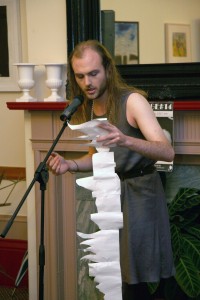 reading from a ripped roll: At a University of Auckland reading in 2010 Brighton showed up wearing a dress and lipstick. Audience members expecting a nice evening of lyrical poetry instead got a long-haired man in drag reading nothing but isolated syllables off a handmade scroll … Brighton’s work is designed to represent and invoke madness or alternative thought patterns … There was another reading in Titirangi — a wealthy West Auckland suburb — with a tape recorder full of sounds of him screaming and babbling. Brighton hung it from the microphone and tried to read over the top of it to create the effect of “different voices competing.” (Interestingly, Ross nowadays notes, ‘I’m not writing much poetry these days, and don't really have much to say …’)
reading from a ripped roll: At a University of Auckland reading in 2010 Brighton showed up wearing a dress and lipstick. Audience members expecting a nice evening of lyrical poetry instead got a long-haired man in drag reading nothing but isolated syllables off a handmade scroll … Brighton’s work is designed to represent and invoke madness or alternative thought patterns … There was another reading in Titirangi — a wealthy West Auckland suburb — with a tape recorder full of sounds of him screaming and babbling. Brighton hung it from the microphone and tried to read over the top of it to create the effect of “different voices competing.” (Interestingly, Ross nowadays notes, ‘I’m not writing much poetry these days, and don't really have much to say …’)
He is a Kiwi. He is a poet. His is poetry. Here is a chapbook of his work too.
Experimental poetry is — at least until it becomes part of the regnant poetic episteme — a revolution, an electric prod into the cerebellum. I surmise that once postmodern poetry/poetics in Godzone/NZ was innovative, nouveau, clever, scurrilous, experimental, but that was nearly 50 years ago now and yet it still oozes through many tertiary creative writing ‘guarantees.’ It once outdated any ‘new poetic,’ but is now as relevant to our Virilio age of sped up interconnection and globalised hyperactivity, as a dead opposum festering arcanely on the highway.
I mentioned Lisa Samuels in an earlier commentary post re: Ka Mate Ka Ora and also her impending new print publication titled Over Hear (Tinfish Press, 2015) in which she, focussing more (but not totally) on experimentalism within-on a text page, lists six identifiable ‘types’ of experimental poem in Aotearoa-New Zealand. They are listed here after a poem by her first — and why not, eh? Experimentalism defies, denies logic, structure, neat bytes of meaning. Ko he wero — it’s a challenge. For both poet and reader and poet as reader.
So far out of flowers human parts
Sure trompe de l’oeil incoming on pip plains
and new like ice, the kick fill in her
shift. I have, and in having halve the heartbeat
of the woman there the rolled bed and equations.
Who made the life like? A woman living huge bodied
macramé and digs. A new way of writing
yet the principle is the same, hired to watch
for mobile bodies ears that pitch shriek
streams a nice crowd instrument.
They thrill in answer, patiently the calibre
of biological furnishings loop woman
and its machine, what? Her feet catch
for the saline push though present’s
co-humane, stripped through for the human
world unspoken to be spoke.
[LISA'S SIX STRIATES: historical looping, lexical parataxis/lexical fracture, haematopoetic, transacted prose, neo-ekphrasis, and digital poetry.]
I want to now run away from Lisa a little and stride into experimental poetry that is still something textual but also striving to be so much more — and that was featured in the very courageous efforts of Orchid Tierney when she instigated REM, an at-first-online representation of concrete and shape poetry and beyond, that also came out in print editions. Orchid is a PhD student at University of Pennsylvania, by the way, and you can blame her for proposing that I write these commentaries!
She notes, ‘REM emerged from a desire to connect NZ poetry with the trends I saw in the States, and I was predominately interested in staging those connections in a digital format. I published a broad range of forms — visual and translingual poetry, artworks, and some fiction. I may have included some conceptual work as well. Unfortunately, the magazine only lasted for 3 issues, and I ended up publishing mostly foreign rather than national talent because I lacked Kiwi submissions. In that sense, it was a failed project. I wonder whether there is some reticence toward digital publishing in NZ, although I don’t think this is the case — mostly I wanted to work outside a public network and that decision certainly didn’t help market the magazine.’ There is now no vibrant REM website, by the way.
Speaking for myself, Rapatahana, REM was NOT a ‘failed project’ by any s t r e t c h of anyone’s imagination: it displayed some great ‘experimental’ material and it is/was primarily because of the stagnant poetic glued fast to the still page that permeates New Zealand poetry, that knobbled it. It didn’t sell. But it sold me and published some of my own experimental work as above re: ngā mōteatea being the tika (true) song-poetry. Kia ora mo tēnei (Thanks for this) Orchid. I do think you underrate your significance to the experimental aspect of the Aotearoa poetic.
Let's step back a bit.
Aotearoa-New Zealand has always had its experimental poets (it’s just that they found far more nourishment for their being off shore.) Like Len Lye. Wrote Roger Horrocksback in 2003 — ‘There has not yet been a full-scale anthology of New Zealand experimental poetry comparable to overseas anthologies such as Jerome Rothenberg and George Quasha’s America a Prophecy: A New Reading of American Poetry from Pre-Columbian Times to the Present or Rothenberg’s Revolution of the Word: A New Gathering of American Avant-Garde Poetry 1914-1945. Such an anthology would subject our tradition to ‘a new reading,’ giving a new centrality to some previously peripheral writers and offering a surprising new slant on familiar writers by focusing on their most experimental work. The early section would surely centre on Len Lye as major ancestor and role model … Knife Apple Sheer Brush is a sensuous tribute to his artist friend Stanley William Hayter, written for The Tiger’s Eye after seeing an exhibition of Hayter’s work in January 1948. It begins:
|
Take a |
knife |
|
|
________ |
Roger’s point about an Aotearoa experimental poetry anthology rings as true in 2015 as it did when he made it. Where is it? Who will ‘publish’?
Then there was Alan Brunton, as pictured here below right. Experimental? Certainly. Check out one of my own favourite Brunton poems titled —
9 PLACES I MEANT TO PUT
IN A POEM
BUT DIDN’T
& 1 THAT I DID (1970–80)
Perhaps the best site to appreciate Brunton is the NZEPC one, which gives us several of his works, such as the one above … while Titus Books has also recently published Beyond the Ohlala Mountains: Alan Brunton / Poems 1968–2002. As below left.
We should also never forget their rightful places in the experimental poetry loop of Aotearoa — for both Wystan Curnow and the late Leigh Davis (below right) must also be mentioned. Wystan is still going strong and the link here is to an excellent overview of him written by John Hurrell; while the NZEPC site provides us much pertinent material for Leigh Davis. Check out his Station of Earth-bound Ghosts — The Flags.
More, Curnow, Alan Loney (inventor of A Brief Description of the Whole World now known as Brief, which will feature later), Tony Green — see below — and Lisa Samuels are all also found as recordings at Penn Sound. The Americano // in New Zealand perhaps. Orchid Tierney mentions, by the way, that, ‘I have been interested in the affinities, correspondences, and discontinuities between NZ and the US experimental communities …’
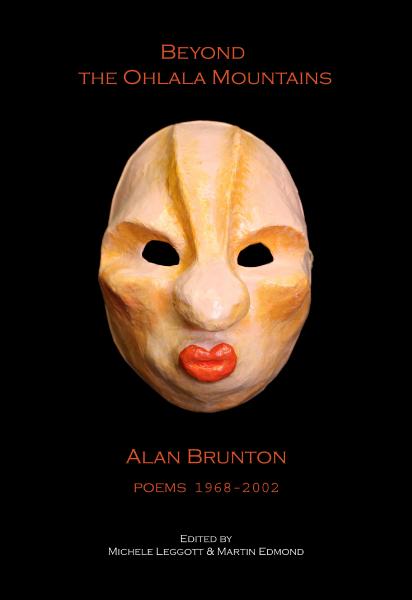 Moving right on back: time means zero.
Moving right on back: time means zero.
Makyla Curtis is an interesting Kiwi experimentalist poet too. Makyla is also coeditor of an extant poetry zine, namely Potroast. Along with Richard Richards and Boris White — photo as below. Experimental poetry is accepted, does appear often in this fine online and print publication.
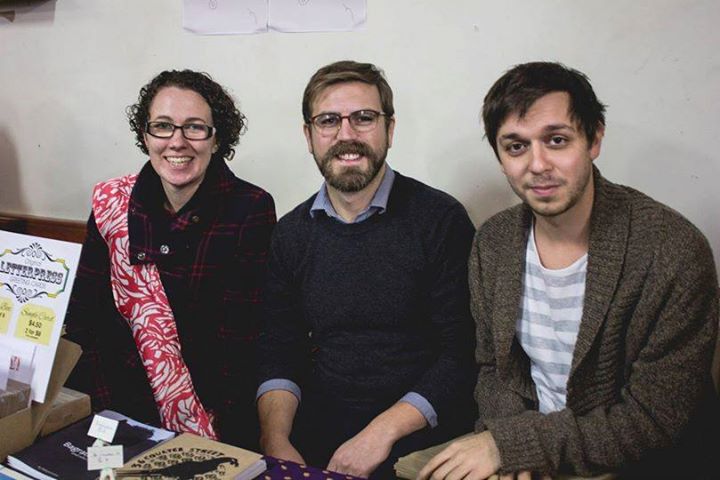
For The Potroast Three, the mission is clear, ‘It’d certainly be exciting to see more interest in and support for experimental poetry, and even more so, it would be wonderful to see more poetry being published in languages other than English. I know that’s tough, because financially there may not be huge audiences for some languages in New Zealand, and in that regard, publishing in English will have the highest possible return on an already small market of poetry publishing. But that seems to us to be all the more reason to be publishing in other languages — using and promoting languages is how we ensure that there are audiences … Also, it’d be great to see more bilingual and multilingual poetry in line with the cultural and linguistic diversity of New Zealand. And this, the multilingual, is something that Potroast is always keen to print more of but this isn’t very often something we receive in submissions which is what we are reliant on … Our approach to picking work is largely on a work by work basis and we really have almost no predetermined rules on what to take. Though one of our key focuses is on the paratext of a poem: poems which address the materiality of writing and its presentation on the page.’ And please take some time to check out Makyla’s own website too: chock full of variegated experimental poetry, from visual through aural to textualized jabberwocky … for example 2 x recent works = a textile vine which is interesting, while This is an Emergency is simply neat! Required listening.
While I am it, mention needs to be made of Otoliths, an all-online poetry publication, founded and edited by an expatriate New Zealand poet, himself an experimentalist, Mark Young, who notes on his site that ‘I'm a New Zealander by birth but have lived most of my life in Australia, currently in Queensland, some distance north of the Tropic of Capricorn. I’ve been publishing poetry for about 55 years, have a few books out there & a couple of blogs’ ... Otoliths welcomes submissions of experimental and digitalized poetry and is rife with it. Ka nui te pai tēnei! (This is excellent!)
… and sticking with/to/in/onto Australia, another simultaneously published online site is Cordite, an e-journal which also welcomes experimental ‘digitally networked poetics … this journal strategically demonstrates the plurality of innovative poetry staged within various international frames’ (Orchid Tierney.) Both of these sites publish on the first day of every month …
Another veteran Kiwi experimentalist poet — and a crony of Wystan Curnow — is Tony Green. Tony immediately points out for me, ‘For several years I have given up trying to get editors to print my work in New Zealand. I am usually not included in readings organised by the NZEPC. I have instead published my work, shortly after making it, on the internet — on my Facebook page, and on my website [ fflap 2 is a pseudonym I have used online a lot for 15 years] …’

The Hammock by Terry Moyle
Terry Moyle is another ‘real’ Kiwi experimentalist poet. He has his own website — check it out, while one critic has noted that ‘his work pushes poetry off the page into real life tangible artefacts. In this way, his experimental works are suggestive of new forms of literacy where text, image and object are inextricably related.’ As shown below, I believe —
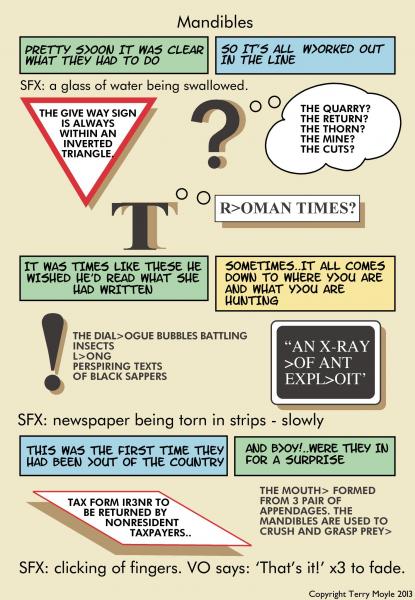
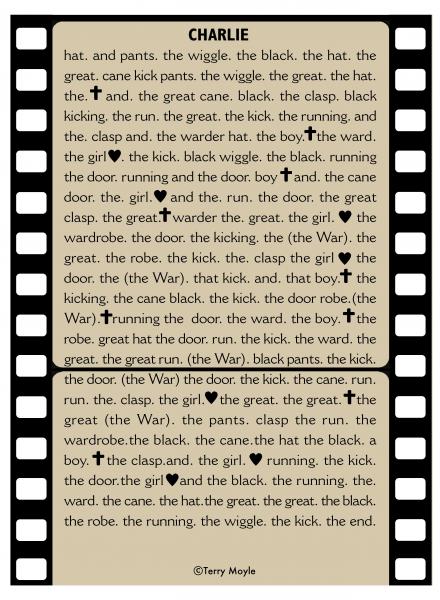
There is going to be another ‘Experimental’ Poetry commentary very soon, so we are nowhere near finished — there’s many more poets to scan and span throughout part two. All of which leads me to surmise that for such a small population there have been and are some particularly innovative poets, given the lack of avenues for them to exhibit their pieces in whatever manner — and given the rubber band critical mass that wraps itself around what Lisa Samuels says is somewhat of a fixation with, ‘stability in the line, word, letter, speaker, reference, and/or author convention … [which] stabilizes a paraphraseable meaning [and] … conjures a consistently readable experience across different readers …’
Bugger that I say.
Let’s exp er i men t, like we did last summer, ex p e ri m en t like we did last year …
Like Makyla Curtis has done here — 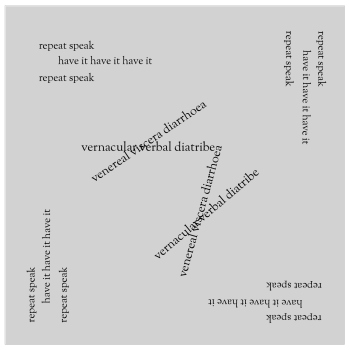 with/in her Verbal Diarrhoea.
with/in her Verbal Diarrhoea.
Ka kite ahau i a katoa. (I’ll see you all.)

Ngā whakaaro